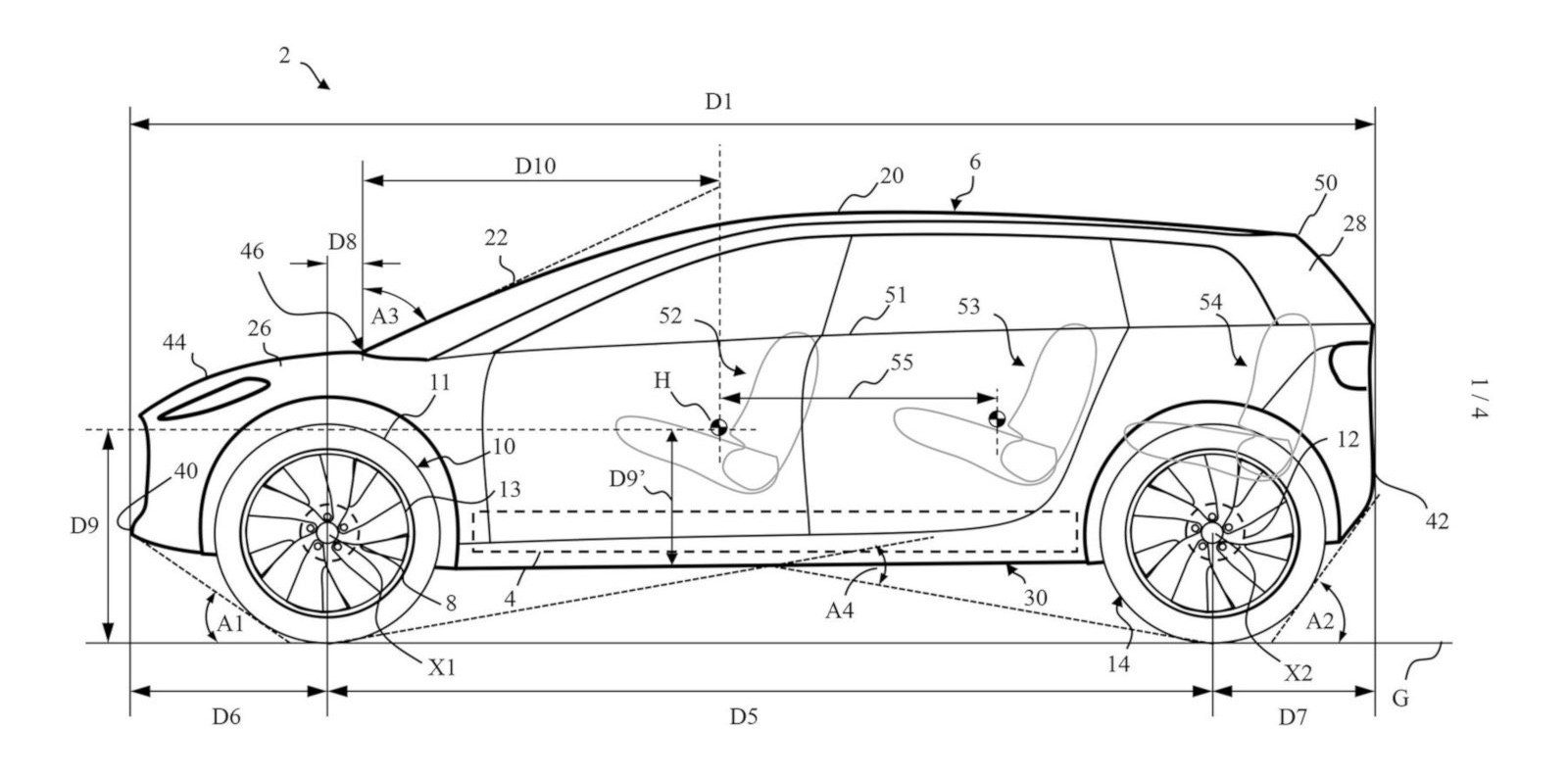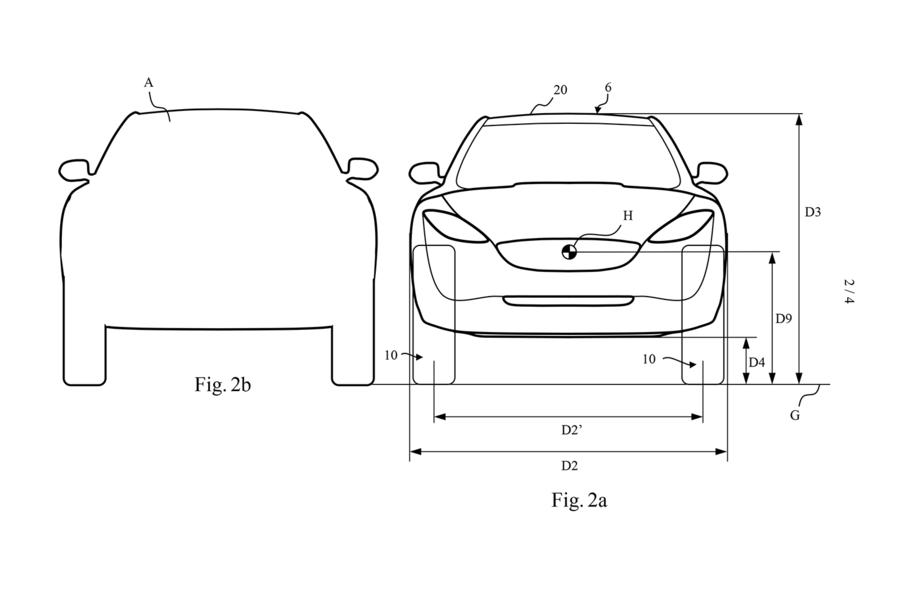Several pioneering features of Dyson’s first electric car, due in 2021, have emerged
PATENTS AND JAMES DYSON REVEAL WHY HIS NEW EV WILL BE A PIONEER
Dyson’s electric car Mould-breaking EV due 2021
Sir James Dyson’s eagerly anticipated electric car is likely to be a long, sleek crossover-style premium model that occupies roughly the same road space as a Range Rover but with completely different proportions from every other existing production car.

Key details of the billionaire inventor’s thinking on electric vehicles have emerged from three patent applications made public on 9 May. They cover the car’s ultra-long wheelbase, unique ‘crossover’ body, unprecedentedly large and thin wheels, short body overhangs and unusually ‘fast’ windscreen. Dyson’s people are keen to point out that these patents don’t necessarily show the production car, which is tipped to be revealed in 2021, in its finished state.
The Dyson car’s long-rumoured existence was confirmed in late 2017, when the inventor revealed plans to spend £2.5 billion of his own money on it. The model has been taking shape for the past two years, led by former Aston Martin chief engineer Ian Minards, who joined Dyson in September 2016 as vice-president, automotive. The new Dyson patents show nothing less than a complete rethink of big-car design and engineering conventions for the fast-approaching electric age. The refinements are aimed at delivering low weight and low aerodynamic drag to maximise performance and battery range, while providing generous cabin space and first-class ride comfort – a particular Dyson priority.
“Everything we’ve seen points to a well-backed, credible, long-lasting rule breaker”
Within the past week, Autocar has spoken exclusively to company founder Sir James Dyson at his base in Singapore, where electric cars will ultimately be manufactured after an initial batch is built at the firm’s £200 million automotive HQ in Wiltshire.
This new UK facility already contains a dedicated technical centre for a 500-strong body of engineers – both Dyson regulars and hires from car makers such as Tesla and Jaguar Land Rover. The facility will eventually spread across six converted wartime aircraft hangars on the 517-acre former RAF Hullavington airbase.
A prototype manufacturing facility will open there next month and a 10-mile test track is also under construction.
SIZE AND PROPORTIONS
In essence, the patents describe a car that is close to the five-metre length of a Range Rover but more than 40cm longer in the wheelbase, at 330cm, with 4-6cm more ground clearance than the Range Rover’s 22cm, yet at least 25cm less overall height, at around 165cm. The car’s layout allows excellent approach, breakover and departure angles, but there’s no suggestion Dyson wants to build a farm vehicle. “It’s just that we can have these things for free,” he said.
This high-floor, low-roof layout is made possible by the location of the car’s wide, long, thin underfloor battery and the adoption of saloon-like seating positions for occupants, giving what Dyson described as a “command” driving position.

The compactness of the (probable) twin electric motors allows a cab-forward layout – assisted by the short nose and raked screen – which enables much of the car’s total length to be used for accommodation. The Dyson patents propose a potential seven-seater, with the rear two rows mounted higher than those in front for good visibility.
A saving of around 10cm on overall width is also possible, said Dyson, because of the lack of a bulky internal combustion engine plus the adoption of narrow-section tyres. A particular Dyson preoccupation is keeping the new car’s frontal area to a minimum, a major contributor to aerodynamic efficiency.
BODY, SUSPENSION, WHEELS
Dyson confirms the car will have an aluminium body, mostly because he and his engineers feel carbonfibre structures haven’t reached the level of maturity they believe the electric project needs. Steel is deemed too heavy.
The patent diagrams suggest a platform-shaped battery mounted beneath the body. Such a battery would need to be encased in an extremely rigid, well-protected structure, which points to the use of a ‘skateboard’ platform chassis supporting suspension subframes front and rear.
Height-adjustable and self-levelling suspension seems likely: Dyson himself points to the pitch-limiting advantages of the very long wheelbase. The Dyson car is likely to have alloy wheels of a highly unusual 23-24in diameter, running thin tyres of around 45-55 profile. The inventor said experiments show these wheels have considerably lower rolling resistance than smaller, wider wheels, while their greater inertia will help with regenerative braking.
This unusual wheel/tyre combination also creates less aerodynamic drag, allows relatively low tyre pressures to be used (for good ride comfort), resists aquaplaning and requires a smaller wheel envelope for less cabin intrusion.
BATTERY AND POWERTRAIN
Dyson’s patent applications contain no powertrain details, but Sir James has confirmed his company is researching two different types of solid-state battery, understood by laymen to be the next big thing after the lithium ion type used almost universally in EVs today.
Dyson’s solid-state battery research is proceeding in four linked global locations, including the UK. It seems a certainty that these advanced, energy-dense batteries will eventually be used in the Dyson car, but there are unconfirmed suggestions that lithium ion may power the earliest cars.
Sir James hasn’t yet specified the car’s motors, except to suggest that more than one motor would make sense because that would increase the potential for power regeneration when the car is coasting and braking. Dyson high-speed electric motor designs are among the world’s best and most compact, so the company will build its own motors for this application and package them very compactly.
MARKET POSITIONING
There’s enough about the specification of a five-metre car with seven-seat capability, powered by an ultra-expensive battery and riding on very special wheels, suspension and brakes to suggest that this will most definitely be a premium car.
Hiring the former Aston Martin chief engineer and inviting a former BMW big-board member, Ian Robertson, onto your board of directors is another indication. Dyson mentioned Range Rovers and Teslas as he discussed his new car, suggesting that, in a money sense at least, they were rivals. But the only speculation about price seems to be on which side of £100,000 of today’s money a Dyson car will sit.
The car will be sold globally and appears likely to have particular appeal in China. No production volume is spoken of, but it seems clear from the size of the engineering effort that this is much more than a bespoke, hand-made effort.
The Dyson name, and the company’s global reputation, will surely help it find markets. Everything we’ve seen points to a well-backed, credible, long-lasting rule breaker of an electric luxury car.



IS IT LIKELY TO BE A SUCCESS?
STEVE CROPLEY
Never let it be forgotten that Dyson makes a hair dryer that costs £299 – when you can buy something that’s meant to do the same job for £12.95.
Such is its reputation for fascinating products and fine design that the eponymous Supersonic is a huge global hit.
This success at finding markets others didn’t know were there has undoubtedly given Sir James Dyson the confidence to invest at least £2.5 billion of his own funds into building an electric car. And it helps already to be a builder of some of the world’s finest electric motors and a world-leading researcher into solid-state batteries. All this is why I’m tipping the Dyson car to be an eventual success, although it could take more time and money. It’s early on, but the seriousness of the effort, the irresistible sense of mission at its Hullavington base and the calibre of the people involved takes this project away from any start-up I’ve ever seen. I reckon when the time comes, worldwide buyers – and I’m guessing there might be as many as 5000 a year – will feel the same.
Q & A JAMES DYSON: WHY WE’RE BUILDING AN ELECTRIC CAR
Sir James Dyson came up with his electric car idea in the 1990s while experimenting with equipment to collect diesel particulates by centrifugal action. He knew exhaust pollution was harmful, but his attempts to sell clean-up technology were overtaken by official directives suggesting diesels were ‘clean and green’.
What is your motivation for making an electric car?
“Nobody was interested in our original exhaust clean-up idea, but we had a bright team developing high-speed electric motors for other Dyson products, we were researching air purification, we had our own aerodynamicists and we were developing solid-state batteries. Put those things together and you’ve the main elements of an electric car.”
What’s your view of the sales potential of electric cars?
“Seems to me industry commentators are underegging the likely growth of the market. People will buy them for the right reasons, because they don’t want to cause pollution. It’s nothing to do with what the industry thinks. The public will decide it wants electric cars.”
Your new car looks big and expensive. Is it a premium product?
“I guess it is. That’s how we generally operate. We’ll make several different versions – different car types, not longer or shorter models. We’re not announcing anything about price yet, but we’re not a mass producer yet. When you go into production for the first time, you can’t be the cheapest. We’ll do our best with that but we’ll be making a big car with a lot of innovation in it, so it won’t be cheap.”
What led you to your car’s unique proportions?
“It’s all about efficiency. The high ground clearance and low roof cut the car’s frontal area, which is one of the keys to efficiency. We wanted a car with good ground clearance, and you get that with big wheels. They have low rolling resistance. They’re better in snow and the wet. You can have bigger brakes. But you still get a big footprint.”
Your patents refer to hydrogen and hybrid power as well as battery propulsion. Will this car be battery only?
“Yes, it will be battery powered. As for battery type, we’re not revealing that yet. But at the moment, we’re researching two different types of solid-state battery in four locations – UK, USA, Japan and Singapore.”
How important is a long battery range?
“I believe the public wants electric cars to go as far as possible. You’ve seen our plans. The car has a big battery pack. But aerodynamics and frontal area are also key to having a good range. People don’t want to be filling their cars with electricity to find they’re inefficient. Having efficient motors means that as well as needing less electricity to propel yourself, you make regeneration more effective.”
You seem very interested in comfort. Will you use air suspension and adjustable ride height?
“Comfort is very important to us and something we definitely want to deliver.
The things you mention are on offer to us. I don’t want to reveal what we’re doing, but suspension is a very important area. Pitch is a good example: if you’ve got a long wheelbase, it becomes more controllable. We’re having fun with all of this.”
You’ve referred a lot to keeping your car’s weight down. We presume you won’t be making this car from steel, then…
“No, we’re not up at those sort of production numbers. But we also want to be able to produce in reasonable volume. We don’t think carbonfibre is yet ready for our sort of operation. It’s an interesting experiment, and okay for very small-volume specialist cars. That just leaves one thing, really.
I don’t think we have to be too revolutionary about the way we do the chassis. I can confirm the car will have an aluminium body, but that’s as much as I want to say.”
What’s your weight target?
“Everyone knows a battery is heavy. But if you do it our way, you get a very low centre of gravity, much lower than an internal combustion car. There is certainly a weight penalty with batteries, but you mitigate it as much as you can and, in any case, and it helps you with regeneration.”
Could you imagine eventually launching cheaper models to attract more people?
“I think that’s going to depend a lot on the progress of technology. If we’re successful with solid-state batteries, that could be a possible moment…”





